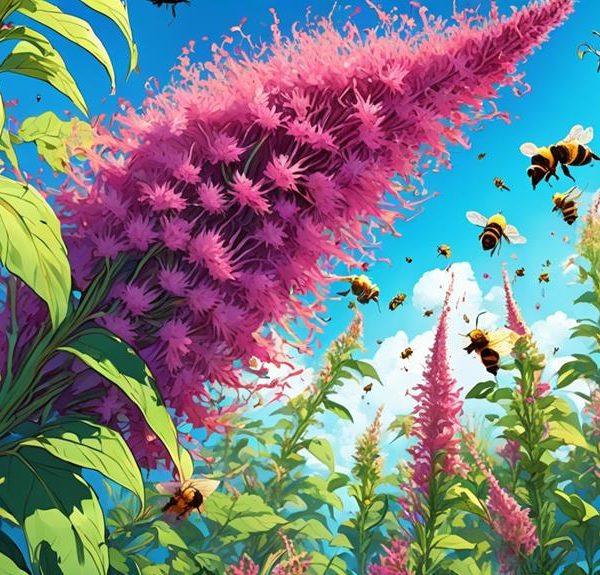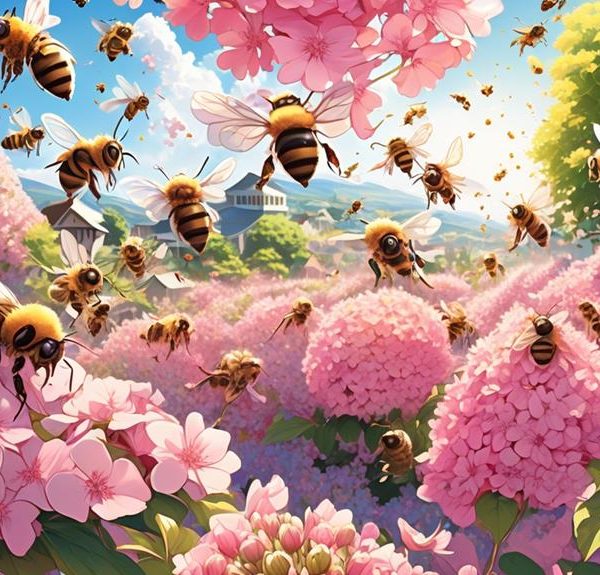Dive into the intriguing relationship between bees and anise hyssop flowers, uncovering why these buzzing pollinators are irresistibly drawn to these vibrant blossoms.
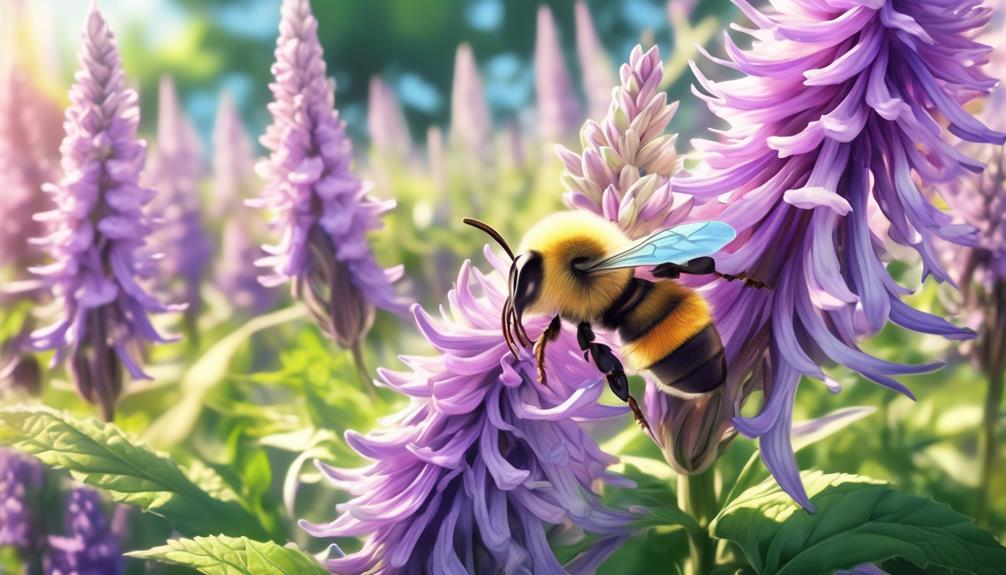
Do Bees Like Anise Hyssop Flowers
By coincidence, you've probably seen bees buzzing around anise hyssop flowers in your garden, but have you ever wondered why?
It's not just their vibrant purple hue that's drawing these industrious pollinators in. As a matter of fact, bees are quite fond of anise hyssop, but the reasons behind this attraction are more complex than you'd think.
So, let's embark on an exploration of this fascinating relationship, and perhaps in doing so, we'll uncover some insights that could help us support these essential creatures in our own backyards.
Key Takeaways
- Anise Hyssop flowers have vibrant purple hues and a rich aroma that attract bees.
- Bees are crucial for the pollination of Anise Hyssop and other plant species.
- Anise Hyssop provides a consistent food source for bees throughout the summer and fall.
- Cultivating Anise Hyssop in gardens can contribute to bee conservation efforts and support local biodiversity.
Understanding Anise Hyssop Flowers
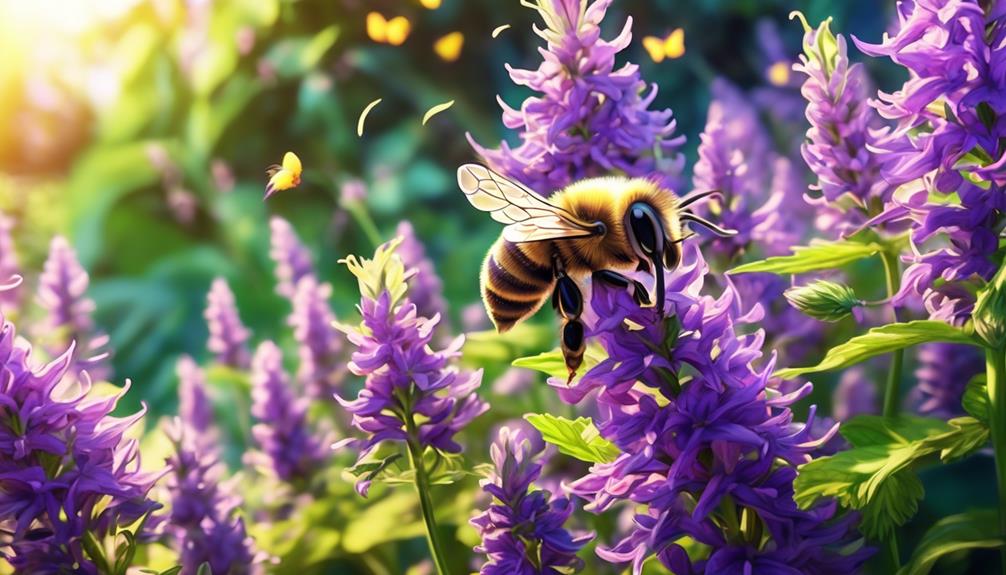
Diving into the world of Anise Hyssop flowers, you'll find they're not just visually stunning, but carry a rich aroma reminiscent of licorice, making them a favorite among bees and garden enthusiasts alike. Known scientifically as Agastache foeniculum, these perennial plants are part of the mint family and boast vibrant purple spikes that reach skywards.
You'll notice that Anise Hyssop leaves have a slight heart shape and a soft, fuzzy texture. They're deep green, creating a striking contrast against the vibrant purple blossoms. Native to North America, these beauties bloom from early summer to fall, gracing gardens with their presence for a generous chunk of the year.
As you lean in closer, you'll pick up the sweet scent which lures bees and butterflies. It's not just the aroma that attracts them, but the nectar-rich flowers. The plants are drought tolerant, deer resistant, and can adapt to a wide range of soils, making them a resilient addition to any garden.
The Bee-Flower Interaction
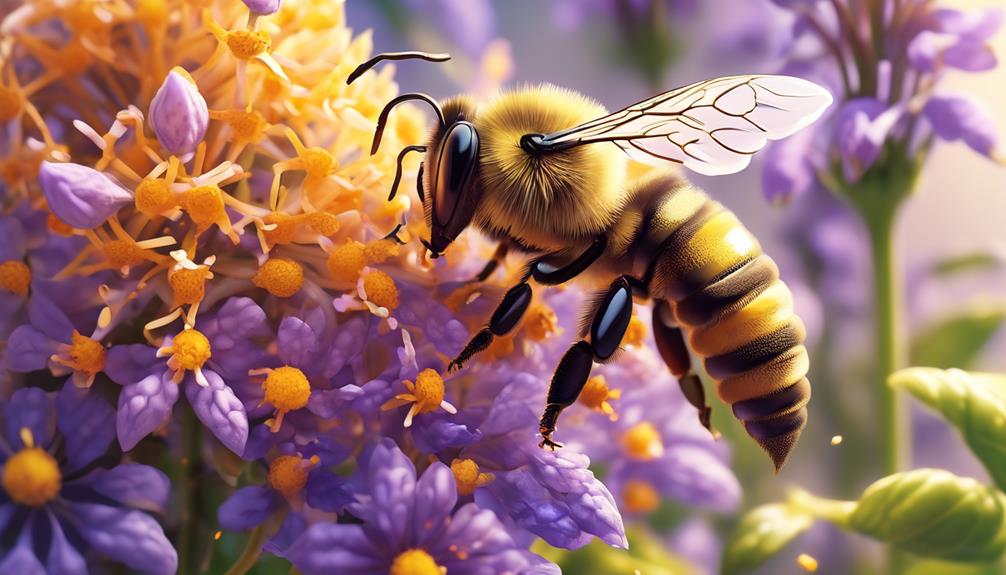
In the dynamic dance of nature, you'll observe bees being irresistibly drawn to the nectar-rich Anise Hyssop flowers, fostering a symbiotic relationship that's as fascinating as it's essential. This interaction is an intricate waltz, choreographed by the forces of evolution and survival.
Anise Hyssop, with its vibrant purple flowers, is a feast for bees' senses. Its unique aroma, a blend of anise and mint, is a siren's call for bees in search of nectar. You'll notice bees tirelessly hovering around these flowers, drinking in the sweet nectar, their bodies dusted with pollen.
What's happening, you ask? It's the brilliant strategy of nature's design. As bees feed, they're also unwittingly playing a crucial role in pollination. The pollen sticks to their bodies and is transported to the next flower they visit, enabling fertilization. This interaction not only ensures the survival of the Anise Hyssop but also contributes to the propagation of a diverse plant species.
Why Bees Are Attracted to Anise Hyssop
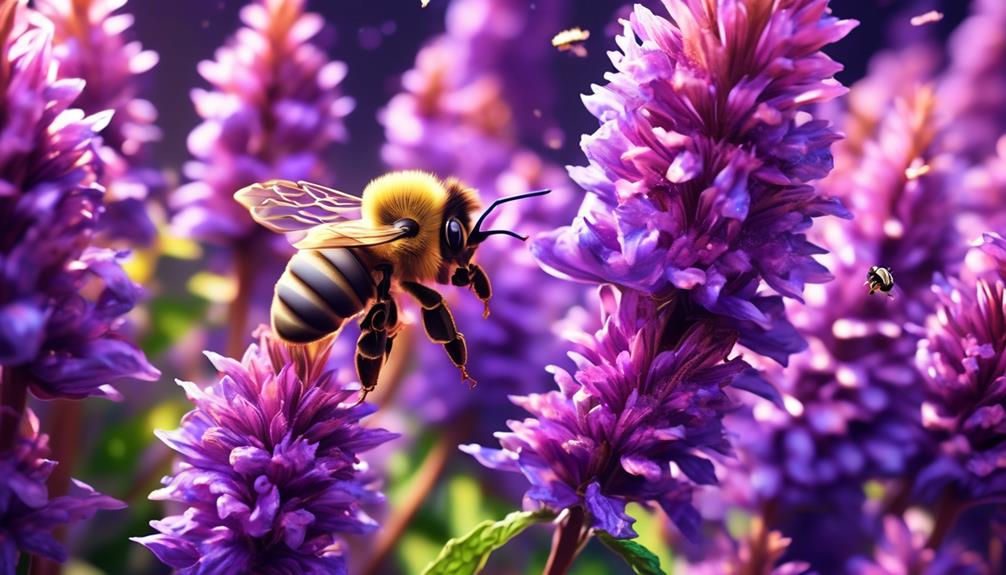
You may wonder why bees can't resist the allure of Anise Hyssop, and it's all about the flower's clever adaptations that appeal to the bees' senses.
In the vast world of flora, Anise Hyssop stands out with its vibrant purple petals, a color that bees can easily spot. Not only does the hue act as a beacon, but it's also a sign of rich nectar reserves which bees need for energy.
The scent of Anise Hyssop is another powerful attractant for bees. It emits a sweet, licorice-like fragrance that can be detected by bees from afar. This fragrance, coupled with the flower's nectar, draws bees like a magnet.
But there's more to the lure of Anise Hyssop than just sight and smell. The flower layout, known as inflorescence, also plays a part. The tiny individual flowers are densely packed, making it an efficient one-stop shop for bees to collect nectar.
Lastly, Anise Hyssop's flowering season extends through summer and fall, providing a consistent food source when other plants have stopped blooming. This ensures that bees will return, reinforcing the bond between the pollinators and the Anise Hyssop.
Anise Hyssop's Role in Bee Conservation

While the Anise Hyssop's unique adaptations certainly enthrall bees, they also play a crucial part in bee conservation efforts. You'll find that these plants offer an abundant source of nectar throughout the summer and into the fall, providing bees with a consistent food supply when other plants may be lacking. They're also a magnet for native bee species, which are vital for local environments but often overlooked in favor of the more well-known honeybee.
Anise Hyssop Attribute | Benefit to Bees |
|---|---|
Abundant Nectar | Consistent food supply |
Prolonged Blooming Period | Long-term resource availability |
Attraction to Native Bees | Supports local biodiversity |
Easy Cultivation | Increased availability for planting |
Anise Hyssop's easy cultivation also plays a role in conservation. It's a plant you can grow in your own backyard, creating a bee-friendly space that helps support bee populations. Imagine turning your garden into a haven for these essential pollinators!
Creating a Bee-Friendly Garden
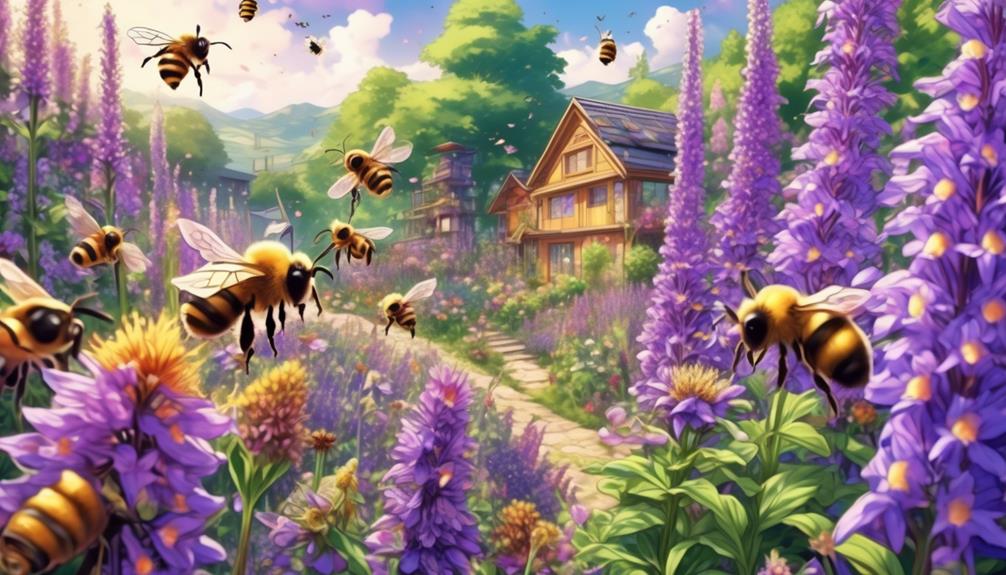
Transforming your backyard into a buzzing sanctuary for bees isn't as daunting as it sounds, especially when incorporating plants like Anise Hyssop. This fragrant perennial is a bee magnet, its lavender spikes offering rich nectar sources. But your bee-friendly garden shouldn't stop there.
Consider diversifying with native plants, as they've co-evolved with local bees and often provide optimal nutrition. Aim for a variety of blooms throughout the seasons; bees need food sources from early spring to late fall. Don't forget trees and shrubs; their blossoms are often rich in pollen, a crucial protein source for bees.
You should also provide fresh water, as bees need to drink too. A shallow dish with some pebbles for landing platforms will do. And remember, avoid pesticides. They're harmful to bees and can disrupt their foraging patterns.
Lastly, provide shelter. Many bee species burrow into bare ground or dead wood. Leaving some untouched areas in your garden can provide much-needed habitats.
Creating a bee-friendly garden isn't just about planting the right flowers. It's about creating a holistic environment that caters to their needs. By following these steps, you'll be well on your way to helping our essential pollinators thrive.
Observing Bees and Anise Hyssop Together
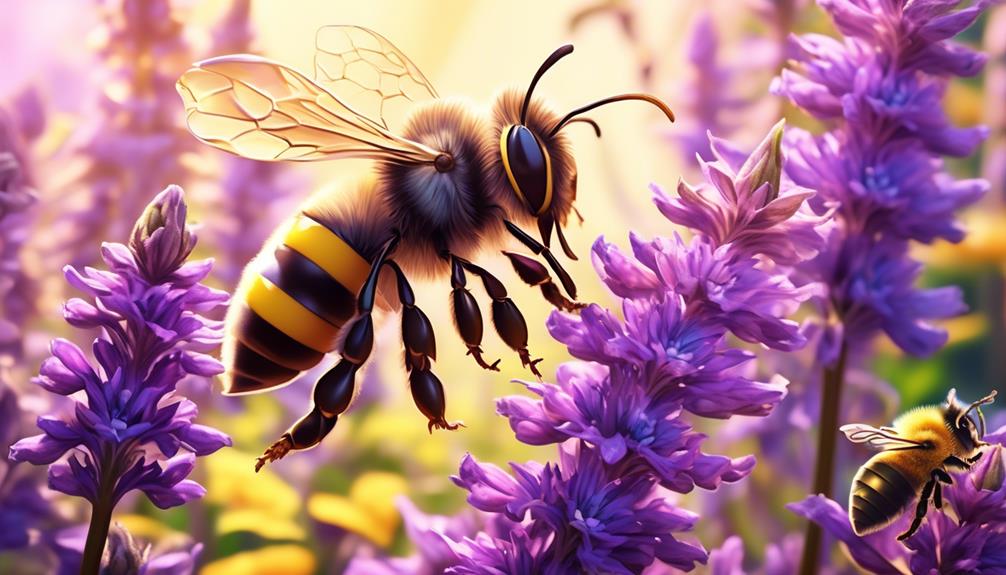
Peeking into your vibrant garden, you'll often spot bees buzzing with delight around the lavender spikes of Anise Hyssop, a testament to the plant's irresistible allure. These bees aren't there by accident. The sweet, licorice-like scent of Anise Hyssop is an irresistible magnet, drawing them in from afar.
Here's a table to help visualize the interaction:
Bee Activity | Anise Hyssop | Observation |
|---|---|---|
Approach | Blooming | Bees are attracted by the plant's fragrance |
Feeding | Nectar-rich | Bees can feed abundantly due to high nectar concentration |
Pollination | Pollen-rich | Bees unwittingly transport pollen, aiding plant reproduction |
Return | Consistent supply | Bees return to Anise Hyssop due to its continuous bloom |
Departure | Fulfilled | Bees leave satisfied, contributing to their survival and hive growth |
As you observe, you'll see bees darting in, landing delicately on the flower spikes, foraging for nectar and pollen. They return to their hive, loaded with sweet nectar and nutrient-rich pollen, only to return for more. The cycle continues, proving that bees not only like Anise Hyssop flowers, but they rely on them. It's an intricate dance of survival, with each partner dependent on the other.
Frequently Asked Questions
What Other Flowers, in Addition to Anise Hyssop, Do Bees Commonly Visit?
You're curious about what other flowers bees typically visit? Well, they're quite fond of lavender, sunflowers, and cosmos, which are all rich in nectar.
Additionally, bees can't resist the allure of daisies, poppies, and zinnias. Of course, wildflowers like goldenrod and yarrow are also high on their list.
Essentially, if a plant produces nectar and pollen, it's likely to attract bees.
It's fascinating to observe their preferences, isn't it?
Do Any Other Insects or Animals Show a Particular Attraction to Anise Hyssop Flowers?
Absolutely, other insects and animals do show a particular attraction to anise hyssop flowers. For instance, butterflies, hummingbirds, and even some beetles are drawn to these flowers. They're attracted by the plant's nectar, color, and scent.
You'll also find that anise hyssop flowers are a hit with certain types of birds. So, it's not just bees who love these blossoms; they're a veritable magnet for various creatures.
Can Anise Hyssop Be Harmful to Bees in Any Way?
You're probably wondering if anise hyssop can be harmful to bees in any way.
Good news! This plant isn't harmful to bees at all. In fact, it's a big attractor for them.
Bees love the nectar of anise hyssop and it's a great plant to include in your garden if you're looking to support the local bee population.
How Does the Weather or Climate Affect the Relationship Between Bees and Anise Hyssop?
Yes, weather or climate can significantly affect the relationship between bees and anise hyssop.
In colder climates, anise hyssop may not bloom as frequently, limiting the nectar available for bees.
Conversely, in hotter, more arid climates, bees may find the plant's moisture-rich nectar especially appealing.
Can Anise Hyssop Flowers Be Used in Any Human Food or Drink Preparations?
Absolutely, you can use anise hyssop flowers in your food and drink preparations. They're known for their sweet, licorice-like flavor, making them a fantastic addition to desserts, salads, and cocktails.
You can even steep them in hot water to make an aromatic tea.
Conclusion
So, do bees like anise hyssop flowers? Absolutely! The vibrant blooms and rich nectar of these plants make them a bee's paradise.
Planting anise hyssop in your garden not only beautifies your space, but also plays a small part in bee conservation.
Next time you spot these purple flowers, take a moment to observe the buzzing activity around them. That's the sound of a happy bee, and a thriving ecosystem.

